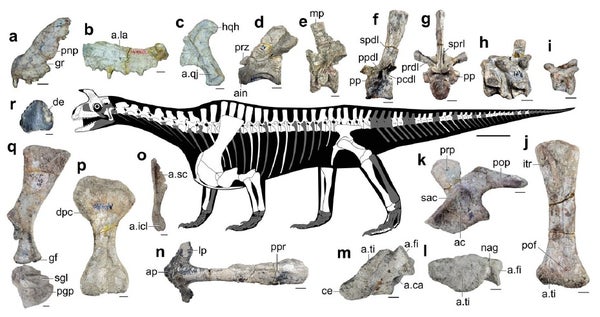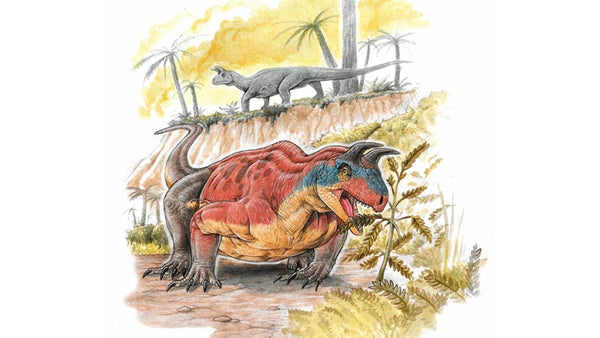This article was published in Scientific American’s former blog network and reflects the views of the author, not necessarily those of Scientific American
The entire Age of Reptiles was filled with fantastic creatures, including our favorite dinosaurs, but the Triassic really sets itself apart for unabashed oddities. Ten million years into the period - quite a stretch in absolute terms but just a relative blip in Deep Time - evolution had spun off the first lanky dinosaurs, marine reptiles with faces like vacuum cleaners, and other creatures that were like nothing that had come before. Now paleontologists have added Shringasaurus indicus to the mix, an unexpected herbivore that took the fossil fandom by surprise.
Shringasaurus, paleontologist Saradee Sengupta and colleagues report, was not a dinosaur. This reptile from ancient India belonged to a different and little-known group called azendohsaurids that, nevertheless, sometimes appear quite dinosaur-like. In particular, the horns of the 247 million-year-old Shringasaurus recall those of the great horned dinosaurs, albeit presaging them by over 100 million years.
Apart from the horns, though, Shringasaurus bears no real resemblance to the ceratopsids. This Triassic herbivore had a relatively long neck on a thick, low-slung body, reconstructed with the rear legs straight and the forelimbs bent out. As was pointed out to me on Twitter, it bears more than a passing resemblance to the poor iguanas that had horns glued to their faces for the 1960 Lost World remake.
By itself, Shringasaurus is yet another Mesozoic weirdo. But placed in the wider context of the Triassic menagerie, this shuffling reptile underscores the resiliency of life on Earth. Shringasaurus, Sengupta and colleagues point out, was part of a great reptilian diversification that occurred after the end-Permian extinction 252 million years ago largely cleared the terrestrial slate. Shringasaurus, in other words, was part of life's wildly experimental phase as extinction survivors proliferated and made a whole new world. Shringasaurus isn't just strange, then, but a sign of life's success.

Reconstruction and selected bones of Shringasaurus. Credit: Sengupta et al 2017
Fossil Facts
On supporting science journalism
If you're enjoying this article, consider supporting our award-winning journalism by subscribing. By purchasing a subscription you are helping to ensure the future of impactful stories about the discoveries and ideas shaping our world today.
Name: Shringasaurus indicus
Meaning: Shringasaurus means "horned lizard", while indicus refers to the country where the bones were found.
Age: Triassic, around 247 million years old.
Where in the world?: Madhya Pradesh, India.
What sort of organism?: A reptile known as an azendohsaurid.
How much of the organism’s is known?: Parts of at least seven individuals found in a single bonebed.
Reference:
Sengupta, S., Ezcurra, M., Bandyopadhyay, S. 2017. A new horned and long-necked herbivorous stem-archosaur from the Middle Triassic of India. Scientific Reports. doi: 10.1038/s41598-017-08658-8
Previous Paleo Profiles:
The Light-Footed Lizard The Maoming Cat Knight’s Egyptian Bat The La Luna Snake The Rio do Rasto Tooth Bob Weir's Otter Egypt's Canine Beast The Vastan Mine Tapir Pangu's Wing The Dawn Megamouth The Genga Lizard The Micro Lion The Mystery Titanosaur The Echo Hunter The Lo Hueco Titan The Three-Branched Cicada The Monster of Minden The Pig-Footed Bandicoot Hayden's Rattlesnake Demon The Evasive Ostrich Seer The Paradoxical Mega Shark The Tiny Beardogs The Armored Fish King North America's Pangolin The Invisible-Tusked Elephant The Mud Dragon The Spike-Toothed Salmon The Dream Coast Crocodile Buriol's Robber Ozimek's Flyer The Northern Naustoceratopsian The High Arctic Flyer The Tomatillo From the End of the World The Short-Faced Hyena The Mighty Traveler from Egg Mountain Keilhau's Ichthyosaur Mexico's Ancient Horned Face Mauricio Fernández's Plesiosaur New Zealand's Giant Dawn Penguin The Orange Sea Lion Mongolia's Ginkgo Cousin The Geni River Frog Isabel Berry's Dinosaur The Whale Caiman The Moab Lizard Yang Zhongjian's Lizard The Little Anubis The Shuangbai Lizard The Wyvern Dinosaur The "Need Helmet" Dinosaur The Jianianhua Dragon The Liaoning Hunter The Dalian Lizard Crompton's Aleodon Jenkins' Amphibian Serpent From the Chinle The Large Ancestor Lizard The Crown Tooth Currie's Alberta Hunter The Elephant Bird Mimic The Crested Thief The Hiding Hunter
